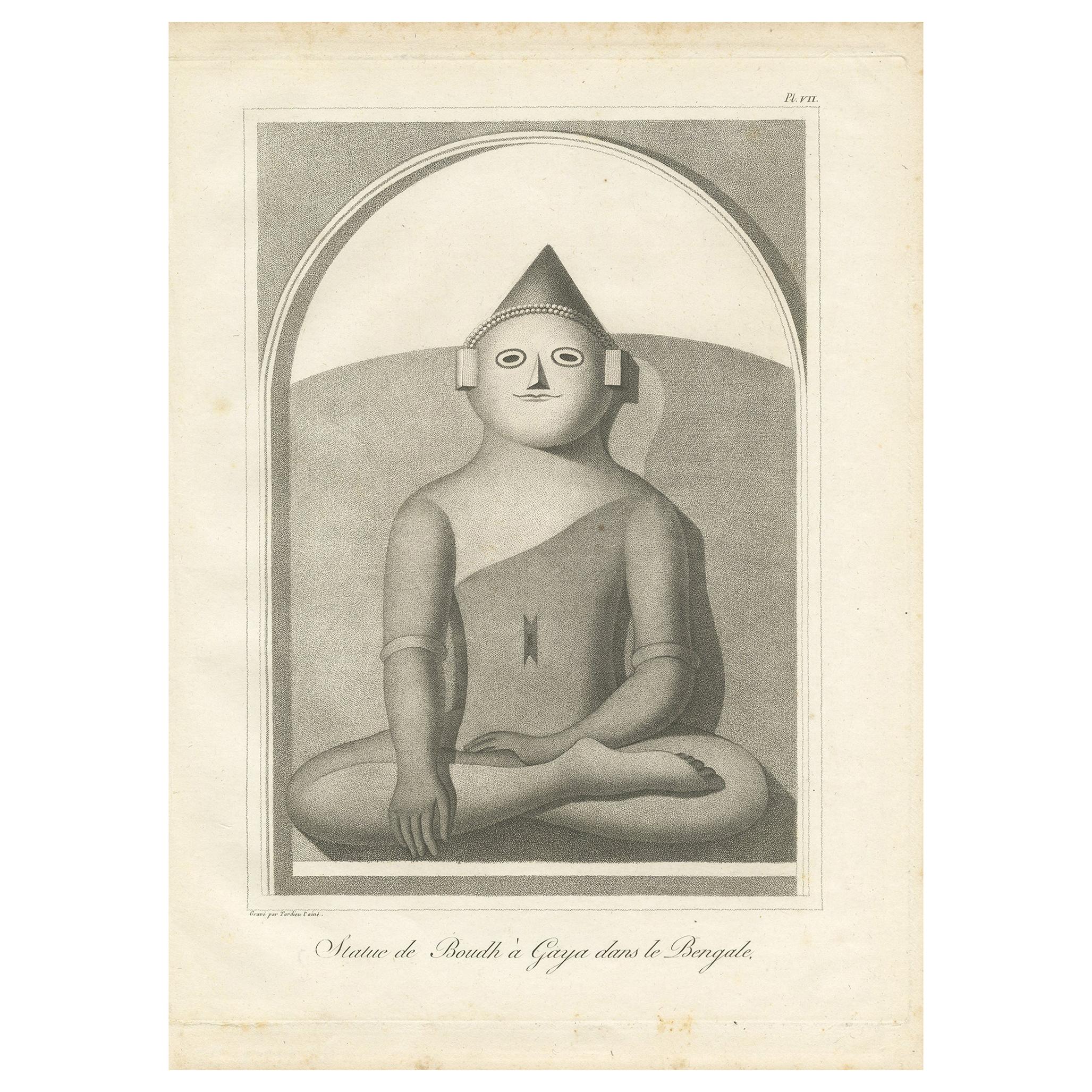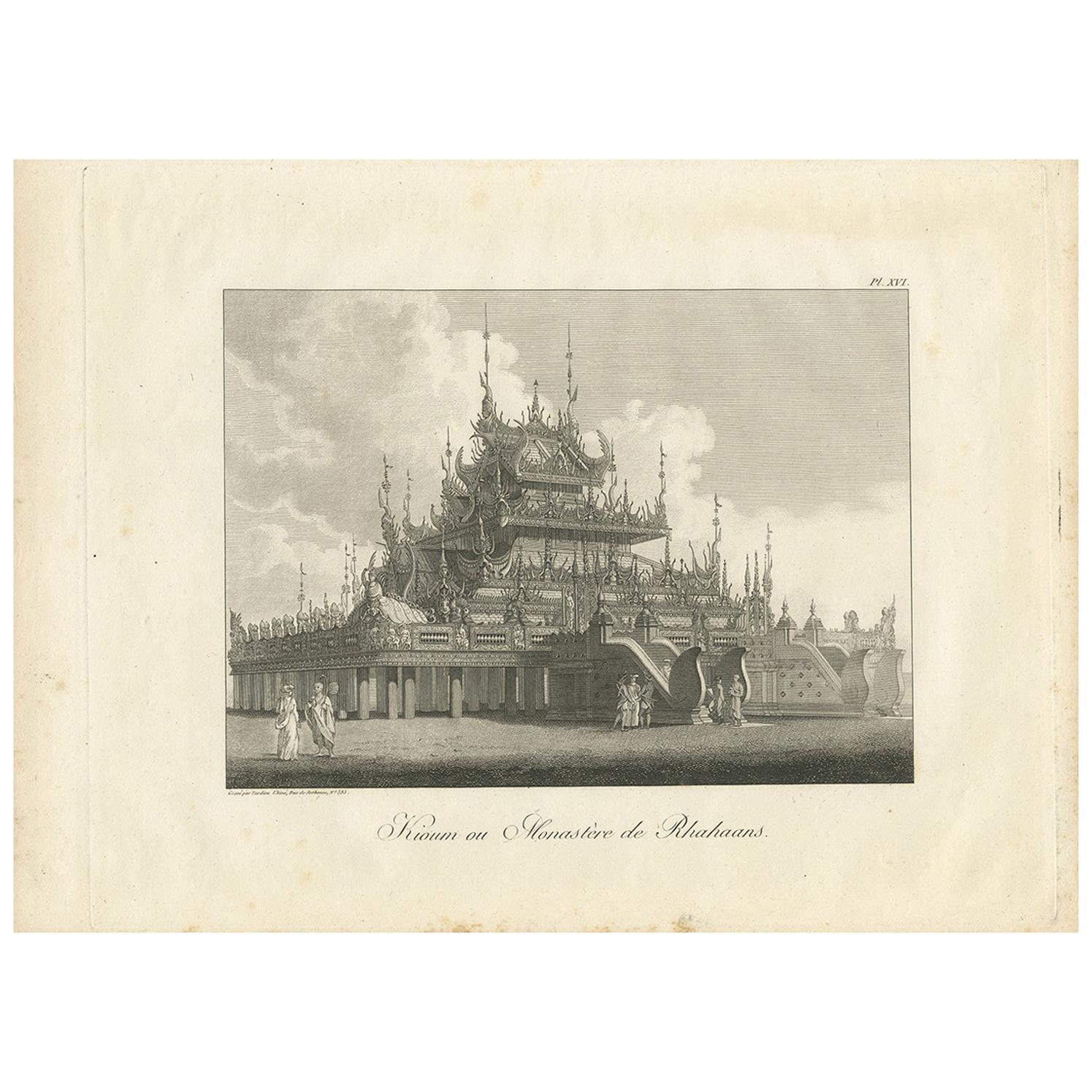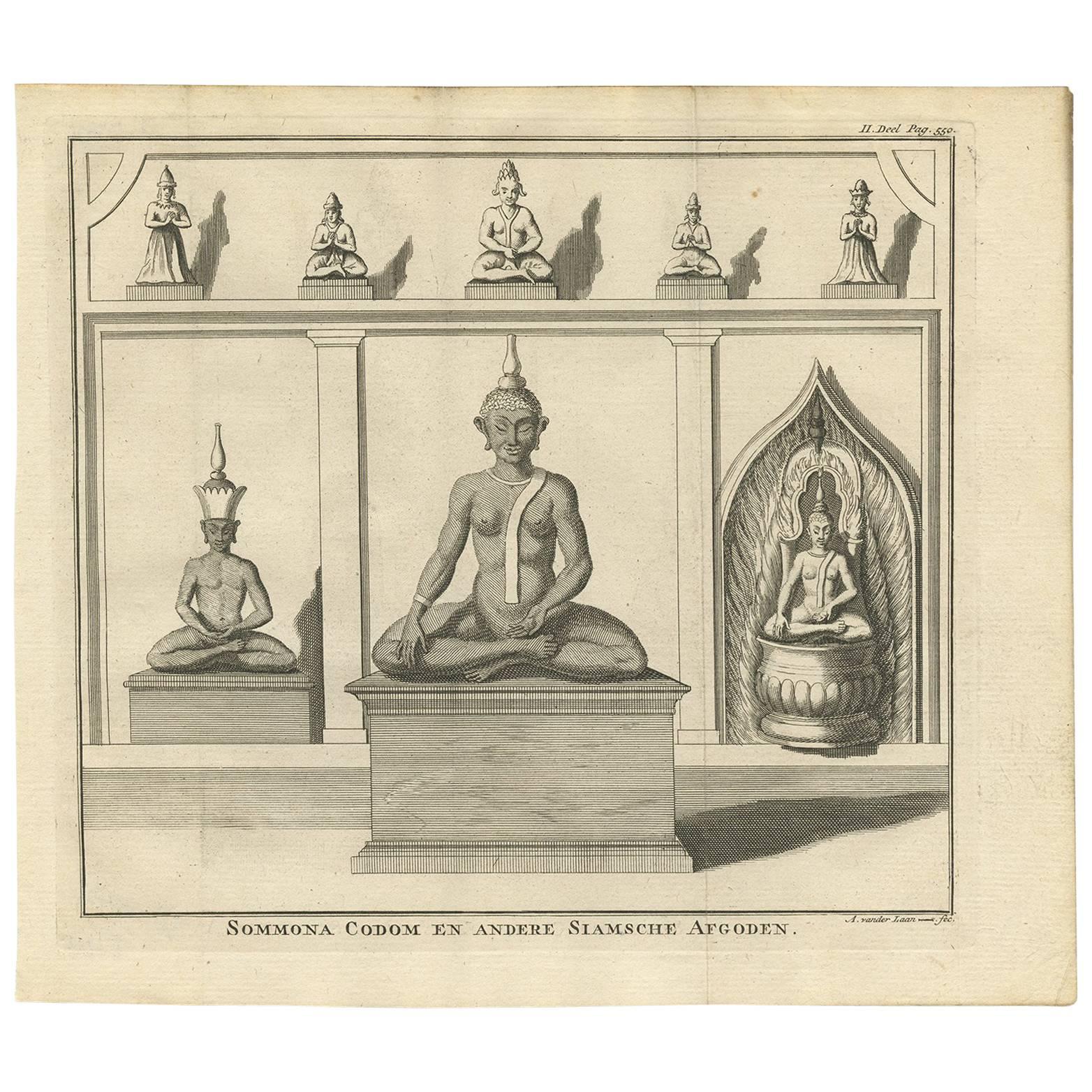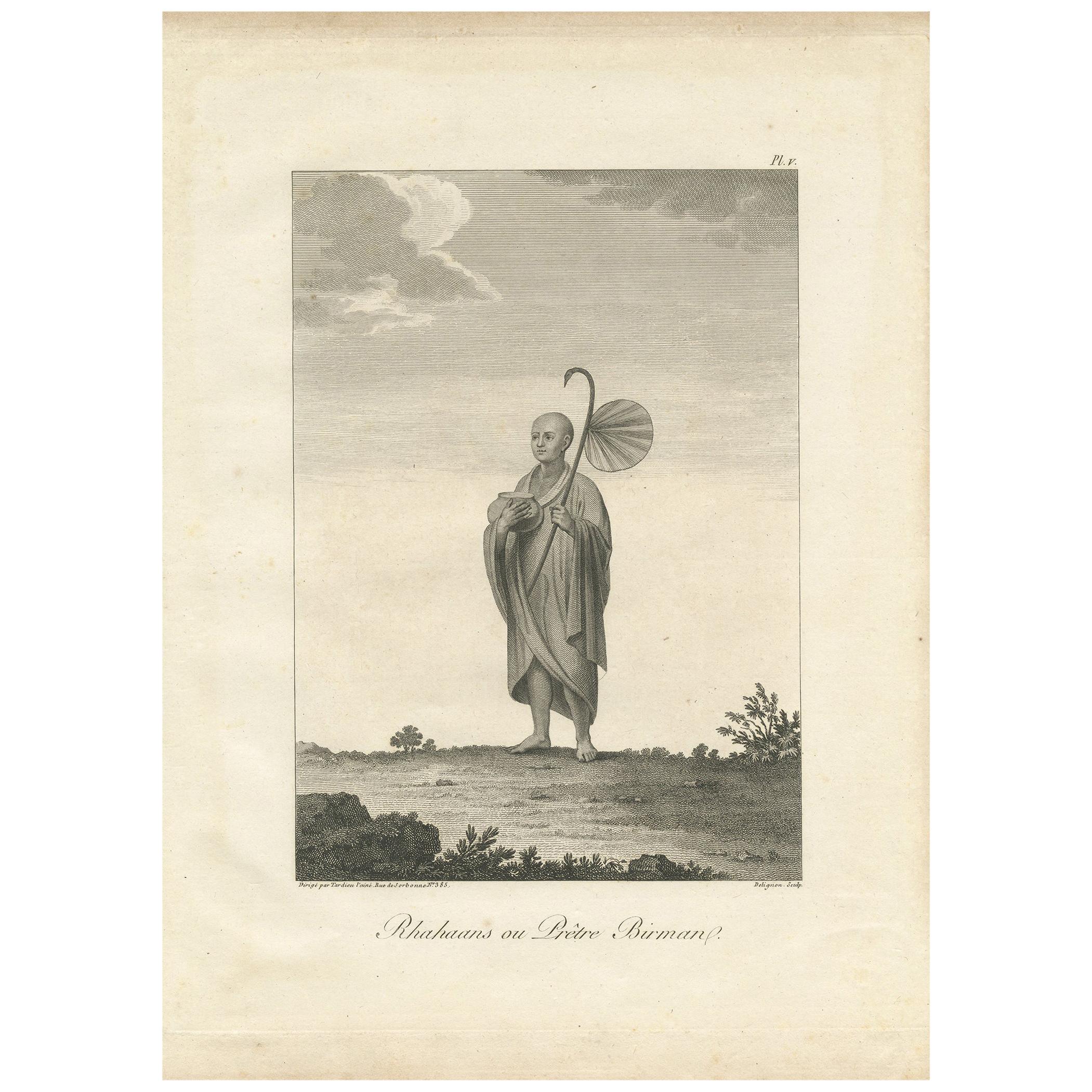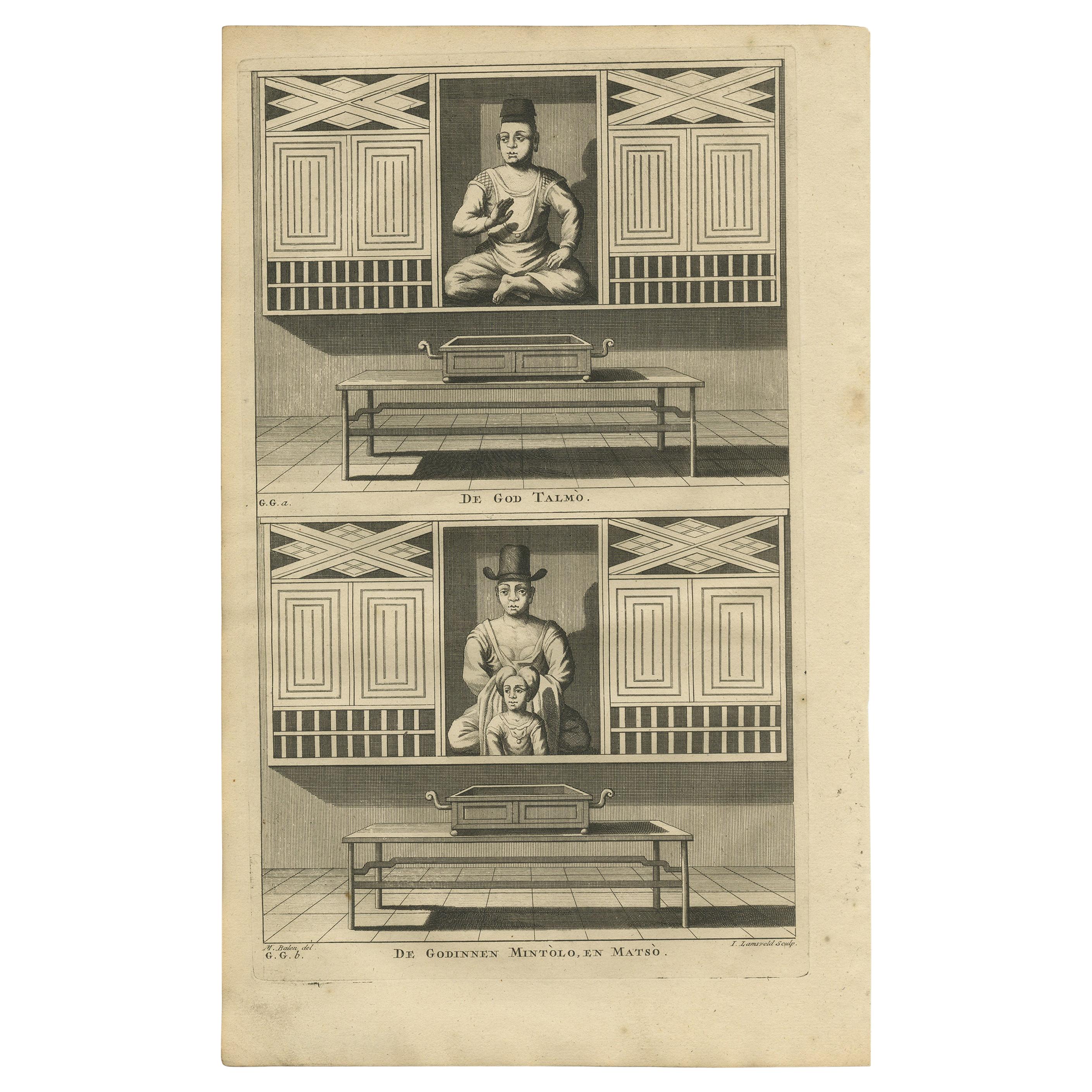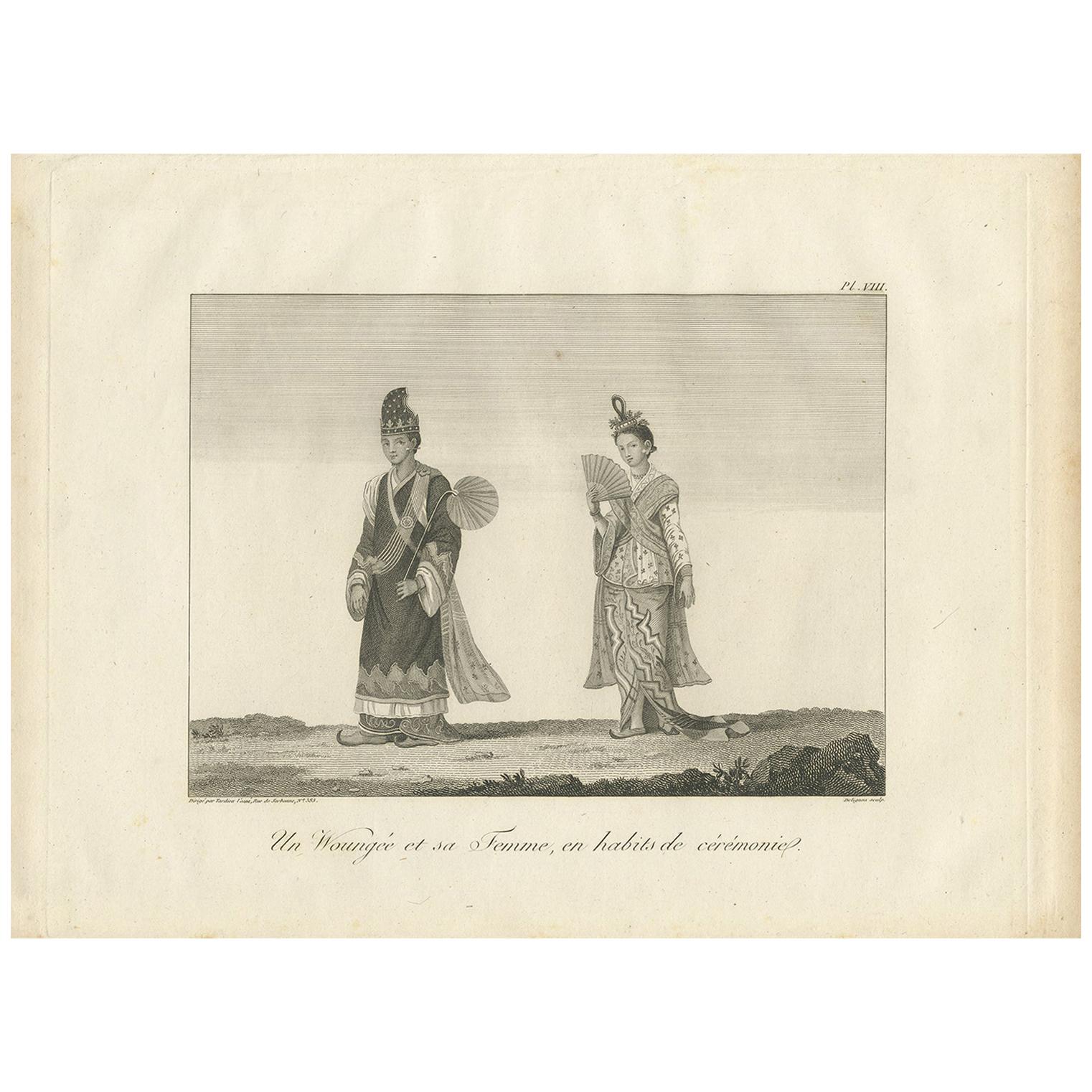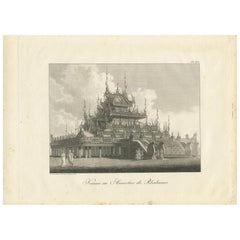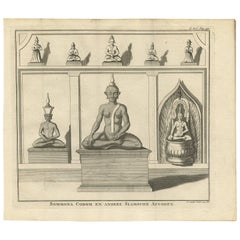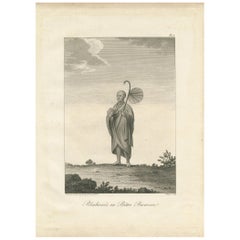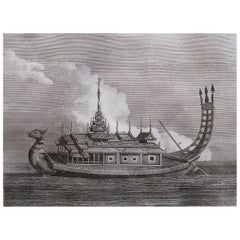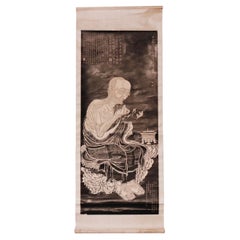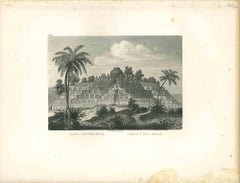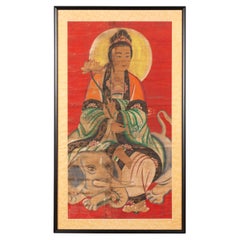Items Similar to Antique Print of a Burman Buddha by Symes '1800'
Want more images or videos?
Request additional images or videos from the seller
1 of 5
Antique Print of a Burman Buddha by Symes '1800'
$143.78
$179.7220% Off
£107.01
£133.7720% Off
€120
€15020% Off
CA$196.94
CA$246.1720% Off
A$219.04
A$273.8020% Off
CHF 114.38
CHF 142.9720% Off
MX$2,665.47
MX$3,331.8420% Off
NOK 1,460.75
NOK 1,825.9320% Off
SEK 1,369.92
SEK 1,712.4020% Off
DKK 913.52
DKK 1,141.9020% Off
Shipping
Retrieving quote...The 1stDibs Promise:
Authenticity Guarantee,
Money-Back Guarantee,
24-Hour Cancellation
About the Item
Antique print titled 'Statue de Gaudma dans un Temple d'Ummerapoura'. Print of a Burman Buddha. This print originates from 'Relation de l'Ambassade Anglaise, envoyée en 1795 dans le Royaume d'Ava, ou l'Empire des Birmans' by M. Symes. Published 1800.
- Dimensions:Height: 13 in (33 cm)Width: 9.45 in (24 cm)Depth: 0.02 in (0.5 mm)
- Materials and Techniques:
- Period:
- Date of Manufacture:1800
- Condition:General age-related toning. Minor wear, blank verso. Please study image carefully.
- Seller Location:Langweer, NL
- Reference Number:Seller: BG-12359-141stDibs: LU3054320941332
About the Seller
5.0
Recognized Seller
These prestigious sellers are industry leaders and represent the highest echelon for item quality and design.
Platinum Seller
Premium sellers with a 4.7+ rating and 24-hour response times
Established in 2009
1stDibs seller since 2017
2,502 sales on 1stDibs
Typical response time: <1 hour
- ShippingRetrieving quote...Shipping from: Langweer, Netherlands
- Return Policy
Authenticity Guarantee
In the unlikely event there’s an issue with an item’s authenticity, contact us within 1 year for a full refund. DetailsMoney-Back Guarantee
If your item is not as described, is damaged in transit, or does not arrive, contact us within 7 days for a full refund. Details24-Hour Cancellation
You have a 24-hour grace period in which to reconsider your purchase, with no questions asked.Vetted Professional Sellers
Our world-class sellers must adhere to strict standards for service and quality, maintaining the integrity of our listings.Price-Match Guarantee
If you find that a seller listed the same item for a lower price elsewhere, we’ll match it.Trusted Global Delivery
Our best-in-class carrier network provides specialized shipping options worldwide, including custom delivery.More From This Seller
View AllAntique Print of the Great Buddha Statue 'Bodh Gaya' by Symes '1800'
Located in Langweer, NL
Antique print titled 'Statue de Boudh à Gaya dans le Bengale'. Print of the Great Buddha Statue (Bodh Gaya). This print originates from 'Relation de l'Ambassade Anglaise, envoyée en ...
Category
Antique Early 19th Century Prints
Materials
Paper
$143 Sale Price
20% Off
Antique Print of a Kioum or Buddhist Monastery in Burma by Symes '1800'
Located in Langweer, NL
Antique print titled 'Kioum ou Monastère de Rhahaans'. Print of a Kioum or Buddhist monastery in Burma. This print originates from 'Relation de l'Ambassade Anglaise, envoyée en 1795 ...
Category
Antique Early 19th Century Prints
Materials
Paper
$143 Sale Price
20% Off
Antique Print of Statues of Buddha and Siamese Deities by A. van der Laan, 1739
Located in Langweer, NL
Antique print, titled 'Sommona Codom en andere Siamsche afgoden.' Statues of Buddha (in Siam/Thailand known as Sommona-Codom) and other Siamese deities.
...
Category
Antique Mid-18th Century Prints
Materials
Paper
Antique Print of a Burmese Priest by Symes, 1800
Located in Langweer, NL
Antique print titled 'Rhahaans ou Prêtre Birman'. Print of a Burmese Priest. This print originates from 'Relation de l'Ambassade Anglaise, envoyée en 1795 dans le Royaume d'Ava, ou l...
Category
Antique Early 19th Century Prints
Materials
Paper
$143 Sale Price
20% Off
Antique Print of Deities of Chinese Buddhism by Valentijn, 1726
Located in Langweer, NL
Antique print titled 'De God Talmo - De Godinnen Mintolo en Matso'. Copper engraving of a god and two female deities of Chinese Buddhism in Indonesia; Talmo and Mintolo, Matso/Mazu. ...
Category
Antique Mid-18th Century Prints
Materials
Paper
$95 Sale Price
20% Off
Antique Print of a Burmese member of the Council of State by Symes (1800)
Located in Langweer, NL
Antique print titled 'Un Woungée et sa Femme, en habits de cérémonie'. Print of Burmese member of the Council of State and his wife. This print originates from 'Relation de l'Ambassa...
Category
Antique Early 19th Century Prints
Materials
Paper
$143 Sale Price
20% Off
You May Also Like
Original Antique Print of The Royal Golden Barge, Myanmar. C.1800
Located in St Annes, Lancashire
Wonderful print of the Royal Golden Barge
Copper-plate engraving
Published C.1800
Unframed.
Category
Antique Early 1800s English Chinoiserie Prints
Materials
Paper
Antique Chinese Printed Ink Rubbing of Panthaka Arhat, (scroll mounted)
Located in Point Richmond, CA
Chinese ink rubbing printing depicting Panthaka Arhat, no.4 of the 16 arhat images immortalized in stone at the former stupa at Shengyin Temple. Depicted here sitting on a rock with a book in his left hand and snapping his fingers in his right hand, symbolic of the speed at which he obtained enlightenment, accompanied by a beggar’s bowl and an incense burner, complete with colophons and silk scroll mounting. The Emperor Qianlong ordered the stone stele to be carved in 1764 after the arhat designs painted by the famed artist Guanxiu (832-912). Even though the temple was destroyed in the Taiping rebellion, the steles remain and have been reinstalled at the Hangzhou Stele Forest. Condition: Creases from rolling, otherwise fine condition. Mounting: 58” x 22”. 19th Century. Ex Collection: Frank “Till” & Peggy Durdin, San Diego.
For other rubbings of this stele see:
Penn Museum, object number 2010-26-4
The Metropolitan Museum of Art AN#: 59.195.15
Fine Arts Library of Harvard University, record id: W280021_urn-3:FHCL:478850
For another example of this image rendered in jade and lacquer see: “Screen Paintings of Guanxiu’s Sixteen Arhats in the Collection of the Palace Museum” Luo Wehhua translated by Bruce Doar, Orientations, September 2010, p. 104. In this article the image is identified as the sixteenth arhat Abheda, It is explained in this article that Qianlong re-identified the arhats, thus the 16th Arhat attribution for this image. Also in this article the identical colophon by Qianlong above the image is translated as: “These accurate portraits of the Sixteen Arhats were created by the Tang Dynasty painter Guanxiu, as recorded in Xuanhe Huapu (Record of paintings in the Xuanhe Reign), and during the millennium from the Guangming reign period to the present day, the original works were to be found in Zhejiang, where they were housed in the collection of Shengyin Temple in Qiantang (Huangzhou). In spring of the dingchou year (1757) of his reign, the Qianlong emperor undertook a southern tour of inspection and stayed at an imperial lodge on the West Lake. He went to the temple to pay his respects and there he saw the arhats on display and wrote a description of these marvels. The sequence of the arhats and their names had been passed down since ancient times, but they did not correspond to their Sanskrit titles; the sequence of the arhat names conformed instead to the interpretation of the Sanskrit classics by the Zhangjia State Preceptor. The emperor penned the original names and positions in the sequence below each of the figures in accordance with the readings supplied in Tongwen Yuntong (Unified Rhymes), and below each he penned an encomium, which he signed. Then the images were returned to the collection, to be passed down as a perpetual treasure. Now, the fourth great arhat had long gone missing and we did not know where his painting was. But it was merely a trifling matter of matching the images with the names, and now surely we have found him! This I, the emperor, believe.”
All 16 of these rubbings can be found in the Rubel Chinese Rubbings Collection at the Fine Arts Library of Harvard University with the following descriptive historical note: “Rubbing from stele depicting No. 4 of 16 arhats (Lohans, Buddhist saints) -- Nan ti mi duo luo qing you, Panthaka Arhat. Original painting attributed to Guanxiu, 832-912. Inscriptions written by Hongli, Emperor Qianlong (Gaozong, 1711-1799) of Qing Dynasty. 7 seals of Qianlong follow the inscriptions. Script style: in xing shu. Shi liu zun zhe -- "The 16 noble ones" are 16 lohans. Lohans are also called "a-lo-han" based on the transliteration of the Sanskrit term "arhat." (Japanese: Rakan; Chinese: Lohan; Tibetan: Gnas-brtan). Arhats or Arahants are saints or sages said to have renounced nirvana (freedom from the cycle of suffering and rebirth), vowed to remain in the world to protect the Dharma and propagate the Law of the Buddha in order to devote themselves more effectively to the relief of human misery, like the Bodhisattvas. These 16 Arhats, personal disciples distinguished by the Buddha, formed part of the 500 claimed by tradition to have attended the First Council in Rajagrha. The names and abodes of these 16 arhats are given in a work entitled "Record on the Duration of the Law, spoken by the Great arhat Nadimitra," which was translated into Chinese by the famous pilgrim Xuanzang (596-664) in 654. 16 lohans are quite often represented, especially in China and Japan, in sculpture and painting, in poses and with attributes. Every lohan can be easily with special icongraphic characteristics. Guanxiu (Jiang Deyin or Deyuan, a Buddhist monk also named Master Chan Yue, 832-912) -- painter during late Tang to Five Dynasties, specialized in painting lohan figures. Legend has it that the first portraits of the 18 Lohans...
Category
Antique 19th Century Chinese Qing Prints
Materials
Paper
Temple à Boro Boudor - Original Lithograph - Half of the 19th Century
Located in Roma, IT
Temple à Boro Boudor is an original modern artwork realized in Germany in the first half of the 19th Century.
Original B/W Lithograph on Ivory Paper.
Inscripted on the central mar...
Category
Mid-19th Century Modern Figurative Prints
Materials
Lithograph
19th Century Indian Print with Guanyin the Bodhisattva of Compassion on Elephant
Located in Yonkers, NY
An antique Indian print from the 19th century depicting Guanyin the Bodhisattva of Compassion. Created in India during the 19th century, this larg...
Category
Antique 19th Century Indian Prints
Materials
Fabric, Plexiglass, Wood, Paper
Le Kelaca à Ellora - Original Lithograph - Mid-19th Century
Located in Roma, IT
Le Kelaca à Ellora is an original modern artwork realized in Germany in the Mid-19th Century.
Original B/W Lithograph on Ivory Paper.
Inscripted on the central margin in Capital L...
Category
Mid-19th Century Figurative Prints
Materials
Lithograph
Thuparamaya - Original Lithograph - Mid 19th Century
Located in Roma, IT
Thuparamaya is an original modern artwork realized in Germany in the Mid-19th Century.
Original B/W Lithograph on Ivory Paper.
Inscripted on the lowet margin in Capital Letters: T...
Category
Mid-19th Century Modern Figurative Prints
Materials
Lithograph
